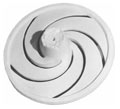 Similar to plaster mold casting, the pattern used in ceramic mold casting is made of plaster, plastic, wood, metal or rubber. A slurry of ceramic is poured over the pattern. It hardens rapidly to the consistency of rubber. This can be peeled of the pattern, reassembled as a mold. The volatiles are removed using a flame torch or in a low temperature oven. It is then baked in a furnace at about 1000 Deg C (1832 Deg F) yielding a ceramic mold, capable of high temperature pours. Additionally, the pour can take place while the mold is until hot.
Similar to plaster mold casting, the pattern used in ceramic mold casting is made of plaster, plastic, wood, metal or rubber. A slurry of ceramic is poured over the pattern. It hardens rapidly to the consistency of rubber. This can be peeled of the pattern, reassembled as a mold. The volatiles are removed using a flame torch or in a low temperature oven. It is then baked in a furnace at about 1000 Deg C (1832 Deg F) yielding a ceramic mold, capable of high temperature pours. Additionally, the pour can take place while the mold is until hot.
 Tolerances can be held to 0.4 %, surface finishes can be better than 2 – 4.5 mm (.075 – .15 in). Add 0.3 mm (.012 in) for parting line tolerances. Wall thickness can be as small as 1.25 mm (.050 in), and the weights can range from 60 g (2oz) to a ton. Draft allowance of 1 degree is recommended.
Tolerances can be held to 0.4 %, surface finishes can be better than 2 – 4.5 mm (.075 – .15 in). Add 0.3 mm (.012 in) for parting line tolerances. Wall thickness can be as small as 1.25 mm (.050 in), and the weights can range from 60 g (2oz) to a ton. Draft allowance of 1 degree is recommended.
This process is expensive, but can eliminate secondary machining operations. Typical parts made from this process include impellers made from stainless steel, bronze, complex cutting tools, plastic mold tooling.
 Sinotech can ensure excellent ceramic mold castings from China, Taiwan and Korea and is very price competitive. Sinotech has audited, qualified and worked with QS-9000 and ISO certified ceramic mold casting factories in China, Taiwan and Korea for over 12 years. Sinotech is dedicated to managing your project on-site and delivering parts to you at lower prices but the same quality, service and terms as a domestic supplier.
Sinotech can ensure excellent ceramic mold castings from China, Taiwan and Korea and is very price competitive. Sinotech has audited, qualified and worked with QS-9000 and ISO certified ceramic mold casting factories in China, Taiwan and Korea for over 12 years. Sinotech is dedicated to managing your project on-site and delivering parts to you at lower prices but the same quality, service and terms as a domestic supplier.
